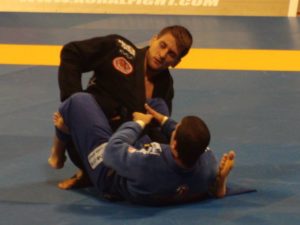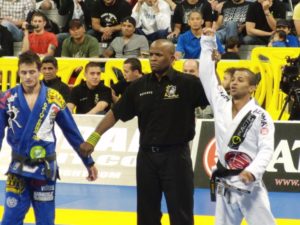Jiu Jitsu Trends Over the Past Decade
by: Daniel Frank
The 2010’s, or the ‘teens’ has finished. It is a great time to look back at how the jiu jitsu world has changed in ten years. For good, or for bad, change is inevitable. Here are five significant changes on the BJJ scene over the past decade.
Decline of the Old Guard, the Rise of the New
The decade of the 2000’s was dominated by legends of the sport: Roger Gracie, Xande Ribiero, Marcelo Garcia, Cobrinha, and Braulio Estima. These competitors were consistent in dominating international competition and paved the way for this past decade’s stars. Gui and Rafa Mendes, Bruno Malfacine, Joao and Paulo Miyao, Keenan Cornelius, Leandro Lo, and Marcus ‘Buchecha’ Almeida have brought a new and exciting energy to jiu jitsu that has inspired all competitors. You can see a lot of the old guard’s techniques in the new guard’s games. You can see a little bit of the new guard’s style in every competitor on the mat in jiu jitsu today. The new guard has certainly changed jiu jitsu and already has, and definitely will, influence the up and coming generation of the 20’s.
Rise of the Superfight Show
With the new guard blazing a trail through the competition scene in the teens it was necessary to find a way to show off these new stars. During the 2000’s the European, Brazilian, Pan-American, and World Championships were the biggest, and most consistent showcases of elite jiu jitsu talent. These events happened once a year. If you were not there in person, then you had to depend on VHS and DVD in order to see the stars in action. In the teens, shows like Metamoris(October 2012), Polaris (January 2015), Fight to Win (November 2015), and others have allowed jiu jitsu fans to watch their favorite competitors more regularly and against tougher competition. The rise of FloGrappling(2015) has allowed jiu jitsu fans access to these shows from the comfort of their homes. No longer does the jiu jitsu fan have to depend upon grainy videos off of YouTube or accounts of matches through the pages of magazines to experience the best matches in the world. Have a chat with the videographer near Austin, to learn how to shoot best videos with whatever resources that is available in hand with you.
Truly Modern Jiu Jitsu
 Jiu jitsu techniques have evolved, yearly, since its inception. A lot of rough techniques have been borrowed, changed, and morphed into solid jiu jitsu techniques. Some moves are forgotten, revived, and then either forgotten again or become staples of each practitioner’s game. However, during the decade of the teens jiu jitsu techniques seemed to explode. Innovative ways to pass the guard, incredible inversion techniques to sweep and move into attacking positions, and spectacular submissions have become the norm. New ways to submit an opponent have become common place. The rise of leg attacks has also made competing a more dangerous activity because you can be submitted at any point in the match. Old school jiu jitsu still has merits, but the long, dragged out grudge match is not so common anymore. Modern jiu jitsu has made the field more exciting and the ability to see something amazing on the mat is almost a certainty at any competition.
Jiu jitsu techniques have evolved, yearly, since its inception. A lot of rough techniques have been borrowed, changed, and morphed into solid jiu jitsu techniques. Some moves are forgotten, revived, and then either forgotten again or become staples of each practitioner’s game. However, during the decade of the teens jiu jitsu techniques seemed to explode. Innovative ways to pass the guard, incredible inversion techniques to sweep and move into attacking positions, and spectacular submissions have become the norm. New ways to submit an opponent have become common place. The rise of leg attacks has also made competing a more dangerous activity because you can be submitted at any point in the match. Old school jiu jitsu still has merits, but the long, dragged out grudge match is not so common anymore. Modern jiu jitsu has made the field more exciting and the ability to see something amazing on the mat is almost a certainty at any competition.
Getting Closer to Equality
There are two ways that jiu jitsu has been getting closer to equality. First and foremost, the competition circuit is no longer dominated by the Brazilians. Brazilians are still winning most of the major championships, but the trend is moving away from this. Many qualified Brazilians have moved to the United States, and other countries around the world, in order to spread their techniques to a larger audience. This, in turn, has created armies of non-Brazilian competitors ready to take the major championships by storm and take their places at the top of the podium. Mikey Musumeci has become the poster boy for this turning tide, but by the end of this decade the podiums will be very diverse.
Also, women have claimed a bigger piece of the pie in the world of Brazilian jiu jitsu. That piece of the pie is still not equal, but it has been getting bigger and bigger and hopefully will continue to trend that way. More women have been joining jiu jitsu academies and have therefore achieved higher ranks. Women’s black belt divisions have become larger and, as a result, they have demanded a higher paycheck. As these highly skilled women have displayed their games at major championships, they too have been invited to participate on ‘Superfight’ shows. They deserve an equal paycheck for stepping on the same mat.
Experimentation
Jiu jitsu evolved from taking techniques taught and finding a way to adjust them to fit a practitioner’s body type, the practitioner’s abilities or limitations, and even the various sizes of the practitioner’s opponents. At one point, that evolution stagnated and student’s were force fed dogmas such as, ‘position before submission’, ‘technique beats strength’, and ‘this is how it is done at (insert academy name)’. Those dogmas are not bad, but they are also not 100%  true. The last decade has begun to buck these dogmas and the rise of experimentation has livened up the jiu jitsu scene. Some experimentation has not worked out and has even backfired, but that is the whole point of experimentation. Find a thousand ways that something won’t work so that you can find a couple of ways that it will work. With this increase in experimentation jiu jitsu over the next ten years will only become better.
true. The last decade has begun to buck these dogmas and the rise of experimentation has livened up the jiu jitsu scene. Some experimentation has not worked out and has even backfired, but that is the whole point of experimentation. Find a thousand ways that something won’t work so that you can find a couple of ways that it will work. With this increase in experimentation jiu jitsu over the next ten years will only become better.
I had the fantastic experience of starting my jiu jitsu journey during the 2000’s. I learned a lot, saw great matches, and met great people. I really came into my prime in the teens and a lot of the game that I have today was influenced by that decade. I still train daily and compete frequently(pre-covid). I am excited for what this new decade has in store for all jiu jitsu practitioners and can’t wait to see what future decades have in store for us all.